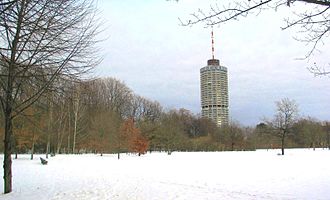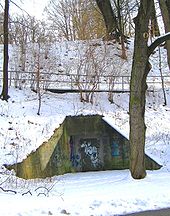Wittelsbacher Park
The Wittelsbach Park is one of the largest green areas of Augsburg . It is 18 hectares and has been a protected landscape area since March 10, 1980 . The total area of the protected area is 20.8 hectares.
The area, often only called Wittelsbacher Park, is made up of the so-called Stadtgarten in the northeast, the actual Wittelsbacher Park and the slope to the Wertach Valley .
The location
- The park begins in the north on Rosenaustraße and Gögginger Bridge.
- The eastern border is formed by the Augsburg congress hall on Gögginger Strasse and the hotel tower .
- In the west the park is limited by the slope to the Wertach valley with its listed canyon forest .
- In the south it ends at the Erhard Wunderlich sports hall and at the toboggan hill at the Rosenaustadion .
Leisure activities and sights
Wittelsbacher Park is popular because of the beauty and diversity of its trees. It also offers several large open spaces as well as a small and a large children's playground. A toboggan hill about 15 meters high closes the park in the south-west. At the north-east entrance at the Gögginger Brücke there is a small artificial lake with a terrace and a beer garden on it. In its concrete basin is a small pavilion from 1886. It was forged from iron by the Augsburg master locksmith Göbel and restored in the 1970s. In summer, a water fountain about ten meters high rises in the middle of the lake .
A Japanese rock garden created in 1957 is integrated into the park . It is called the Rudolf Diesel Memorial Grove in memory of Rudolf Diesel from Augsburg and his invention of the diesel engine in 1897. It is around 1,000 square meters in size and surrounded by hedges. The green area was designed with large boulders up to two meters high, which were transported to Augsburg by the Japanese river Inagawa . The grove was donated by Magokichi Yamaoka , then head of the Yanmar Diesel Works, which produced diesel engines in the Japanese cities of Amagasaki and Nagahama . The park was officially handed over to the Augsburgers on October 6, 1957. Yamaoka also campaigned for the two cities to become twin cities of Augsburg in 1959 , the first German-Japanese city partnerships .
In 1924 the Augsburg department of the German Colonial Society planted a "colonial linden tree" west of the playground in Wittelsbacherpark . The occasion was the 40th anniversary of the acquisition of Lüderitz Bay in German South West Africa . The German "colonial hero" should be commemorated with the linden tree and the population should be urged "not to rest until the hostile robbery of our colonies is atoned for".
Bunker system
From 1944 to 2001 there was a large bunker under Wittelsbacher Park . The air raid tunnels were built in 1944 and designed for 1,200 people. The trigger was the night bombing raid by the British Air Force from February 25th to 26th, 1944, which left 730 dead and over 1,300 injured. Half of the Augsburgers then left the city.
The underground facility extended from Schießstättenstraße to Christoph-von-Schmid-Straße. The kilometer-long corridors were, for example, under the Rudolf Diesel Memorial Grove and under the eastern edge of the Rosenaustadion (Rosenauberg). A corridor extends up to 20 meters from the hotel tower . The corridors were partially laid out parallel and connected with cross corridors. Only a small part is still preserved today.
The narrow corridors, some of which are only 1.40 meters high, were laid out in a very short time in order to be able to quickly offer protection to the citizens who stayed there. The largest room offers standing height and only holds 15 people.
The bunker was sparsely furnished. Portable carbide lamps provided light. There were no sanitary facilities. Those seeking protection sat on folding bench seats against the walls. The fresh air was supplied via air protection shafts.
After the war, the Augsburgers removed the wooden beams and boards with which the bunkers were temporarily clad. Parts of the facility that belonged to the federal government collapsed. In 1962 it was renovated for five million marks, the corridors were now concreted, but no longer used.
From 1990 the tunnels, which are up to 14 meters underground, belonged to the city of Augsburg. Urban plans to use it as a shelter failed because of the costs. According to an appraisal, the necessary renovation should cost 7.5 million marks. So the backfilling was decided.
It was only filled in 2001 for 600,000 marks. It was urgently needed, in the meantime even a mower in the city collapsed when a tunnel gave way. A mass of rock flour mixed with water was used and allowed to flow into the cavities. For environmental reasons, the initially discussed use of slag from the Augsburg waste recycling plant was dispensed with. Two examples illustrate the dimensions: In the Rosenauberg "tunnel system I" was closed with 1,700 m³ of "filler binder", and "system II" was filled with around 1,000 m³ of rock mass. The tunnel exits were secured with 40 m³ of concrete.
However, two tunnels on Schießstättenstraße remained. They are not open to the public, but are open for fire and disaster protection exercises or for guided tours.
History of origin
Even before a park was set up, the (meadow) area was called "Thennsches Gartengut". After the city of Augsburg took over the site from private ownership, the city nursery was opened on the part of today's city garden and remained there until 1936. It was then moved to the current location of the botanical garden and reopened there on September 26, 1936.
In the years 1885 and 1886, the forerunner of today's city garden was created under the name "Amusement Park". The occasion was the establishment of an exhibition area for the “Swabian District, Industry, Trade and Art History Exhibition”, or “Large District Exhibition” for short, in 1886. It included several large halls made of wood, a café and a music pavilion.
From 1895 to 1897, the park was expanded to include the “Rosenauberganlagen”. The 15 meter high "Rosenauberg" is more of a slope, on which the Rosenaustadion has leaned since 1951, and borders the park to the southwest. In 1906 this part was named "Wittelsbacher Park". It was named after the Wittelsbachers , a German aristocratic family from which the Bavarian rulers emerged for centuries.
Changes over time
After the circular exhibition ended on September 30, 1886, many exhibition buildings were dismantled. The new Augsburg City Garden Association has now transformed it into an attractive city park for the citizens of Augsburg. For example, a large concert hall for 2,000 guests was built in 1889, which was destroyed by fire in 1910.
In 1900 the wooden singing hall was opened to complement the remaining exhibition building. It was built for (singing) events and with a capacity of over 6,000 people and burned down on May 1, 1934 after an arson attack .
Due to fires and war damage, only the small pavilion at the park entrance remains today. A small part of the cobblestone driveway from Rosenaustraße has also been preserved.
In place of the earlier concert hall, the Ludwigsbau was built in 1913–1914 according to plans by Augsburg city planning officer Otto Holzer . It was badly damaged in the Second World War in 1944 and blown up in 1965 because of alleged dilapidation to make way for the new congress hall. In 1972 the park lost its area in the east in order to integrate the congress hall and the hotel tower, which was also opened in 1972 . Many Augsburg citizens and preservationists were against the hotel building and the encroachment on the park. The result was a - ultimately unsuccessful - citizens' initiative “Save the Wittelsbacher Park”.
Seven years earlier, in 1965, the architecturally sophisticated, today's Erhard Wunderlich sports hall was opened near the Rosenaustadion at the southern end of the park . This time, however, the necessary redesign enriched the landscape architecture .
The overall impression of the Wittelsbacher Park is shaped in the northern part by the exposed concrete buildings of the 1970s. The old trees, open meadows and playgrounds dominate in the south.
The “ Reichenberger Brunnen” stands next to the main entrance of the congress hall . It is a gift from the Sudeten Germans who were accepted as refugees in Augsburg after the Second World War. It is richly decorated with reliefs on the history of Reichenberg.
Longstanding trade fair location
The traditional Augsburg spring exhibition, AFA for short, a trade show, pitched its tent halls from 1951 to 1954 next to the Ludwigsbau. Due to a lack of space, in 1955 it moved to the south-eastern part of the park with its large open space. This reduced the park by 3.5 hectares.
At the beginning of the 1970s, Augsburg's resentment grew louder and louder. The first plans for relocating the fair were made. In 1987 the last "AFA" took place in Wittelsbacher Park. The new Augsburg exhibition center around the Schwabenhalle opened in 1988 and hosted the spring exhibition .
Modular festival
From 2012 to 2018, the “ Modular Festival ”, the largest non-commercial youth and pop culture festival in the Augsburg region, took place in Wittelsbacher Park and in the adjacent congress at the park .
Web links
Individual evidence
- ↑ Stadtarchiv Augsburg 34/15
- ↑ http://www.augsburg.de/kultur/festivals/modular-festival/
Coordinates: 48 ° 21 '30.1 " N , 10 ° 52' 57.4" E










